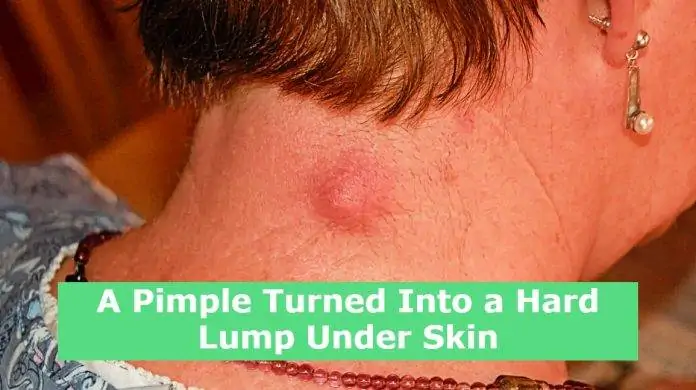If you are experiencing a pimple turned into a hard lump under skin then you have some options available to you. One option is to use a cream to remove it. Another option is to visit a doctor to get a consultation to find out what to do to clear up your acne.
Papules
If you notice a small, red bump on your skin, you may be dealing with a papule. Papules are blemishes that are usually caused by acne. They can occur anywhere on the face, but most often appear on the nose.
The most common cause of this blemish is clogging of the hair follicle by dead skin cells. When these pores become blocked, the body sends a chemical called pus to fight the infection. However, this is not the only way a papule develops. Other causes include genetics, stress, and hormones.
While papules are a normal part of a person’s skin, they can be annoying. Fortunately, there are treatments for them.
Whiteheads
When a pimple turns into a hard lump under the skin, it is usually because the pore is clogged with oil, dirt, and other debris. A clogged pore can also be caused by genetics, hormones, or by the use of certain medications.
Acne is a skin condition that can be painful, and if left untreated, can result in scars. There are several types of acne blemishes, including whiteheads, blackheads, and nodules. The type of acne you develop depends on your age, your diet, and your skin’s sensitivity.
If you are experiencing a mild outbreak, you may be able to treat it yourself at home. However, if your pimple is more serious, you may need to visit a dermatologist for medical treatment. Some dermatologists will recommend a long-term plan, which may include prescription topical treatments, retinoid therapy, or a corticosteroid injection.
Cystic acne
If you’ve ever had a pimple that turned into a hard lump under your skin, you know how painful it can be. Cystic acne can also be very difficult to treat. You might have to try several different treatments before you find one that works.
Fortunately, you have a lot of options when it comes to treating your acne. Some people are better off going to a dermatologist, while others will be able to get rid of their breakouts with over-the-counter medications.
To start, you should avoid picking your pimples. This can lead to an infection, which can leave a scar. Also, don’t apply any homemade remedies to your skin. These can irritate your pores, which can make your pimples worse.
Nodular acne
A pimple turned into a hard lump under skin can be uncomfortable. It can also leave behind red, dark marks. However, it is important to know that it is possible to treat this type of acne.
Nodules are a kind of pimple that is often difficult to distinguish from others. They can be deep beneath the surface of the skin, meaning they are difficult to see.
Nodules usually occur on the face and back. However, they can also appear on the neck. If you have nodules, it is important to consult with a dermatologist, since they can offer treatments that will help to alleviate the problem.
Melanoma
Melanoma is an abnormal growth on the skin, which can be harmless or cause pain and discomfort. The condition occurs when the skin cells begin to break down from excessive exposure to ultraviolet (UV) light. It can occur on any part of the body, but it’s more common on areas exposed to the sun.
In most cases, melanoma begins on the surface of the skin as a small, raised bump. However, it can also develop inside an existing mole. When it starts to grow, it can become painful and bleed easily. If you notice an abnormal growth on your skin, you should contact your doctor immediately.
Lipoma
Lipomas are benign overgrowths of fatty tissue that develop under the skin. They usually occur in the neck, upper back, shoulders, armpits, or thighs.
Although lipomas are generally harmless, they can be uncomfortable and painful. In addition to the pain they can cause, they can also affect blood vessels and nerves. A doctor can remove a lipoma surgically.
Most lipomas are small and can be felt only when they are touched. They are typically less than two inches wide. However, they can be larger. If a lipoma is large, a doctor may recommend a surgery.
Lipomas can be felt under the skin, but sometimes they are hard and cannot be felt at all. When they are felt, they can feel like a soft oval-shaped lump.




